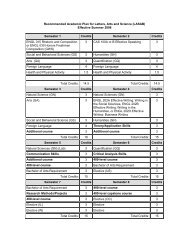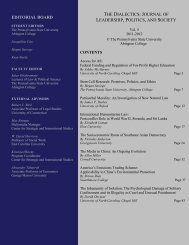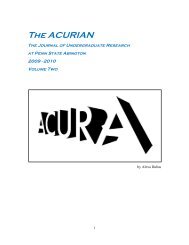Vol. III - Penn State Abington
Vol. III - Penn State Abington
Vol. III - Penn State Abington
Create successful ePaper yourself
Turn your PDF publications into a flip-book with our unique Google optimized e-Paper software.
REFORMING THE CREDIT RATING AGENCIES:<br />
A COMPREHENSIVE SOLUTION<br />
By Yuqing Wu ∗<br />
The George Washington University<br />
Elliott School of International Affairs<br />
When the subprime mortgage crisis broke out in 2007, few people could imagine that<br />
this crisis would evolve into a global financial tsunami. Of course, many institutions, including<br />
government agencies, are responsible for this crisis. Among them, credit rating agencies (CRAs)<br />
have aroused drastic disputes, and not for the first time. After the Enron Scandal and the IT<br />
bubble, CRAs were blamed for their failure to forecast these affairs (U.S. Securities and<br />
Exchange Commission, 2002). Criticism of CRAs has become even fiercer this time around,<br />
because they have played such a central role in the current crisis.<br />
The present financial crisis was mainly triggered by residential mortgage-backed<br />
securities (RMBs) and collateralized debt obligations (CDOs). RMBs are financial products,<br />
usually created by investment banks, that package hundreds or thousands of subprime mortgage<br />
loans into a pool. A trust purchases these pools and becomes entitled to the interest and principal<br />
payments. The trust then issues RMBs to investors in order to finance the purchase (U.S.<br />
Securities and Exchange Commission, 2008:6). In this way, investors receive their interest and<br />
principal payments through the interest and principal payments from the pool. Based on the<br />
RMBs, the CDO is created to ensure the value of the investments to RMBs, making the process<br />
even more complicated (U.S. Securities and Exchange Commission, 2008:9).<br />
Because the debt chain had been largely extended, it was difficult for investors to assess<br />
the risk of these products, even though many of them were managed by financial elites like those<br />
working at AIG. So, investors relied largely on CRA ratings of complicated products such as<br />
RMBs and CDOs. Credit rating agencies showed great optimism for these structured finance<br />
products, especially CDOs. Based on the same mortgage asset pool, 80% of CDOs could get a<br />
Triple A (AAA) rating (Zhao, 2008). Not surprisingly, CRA involvement greatly stimulated the<br />
explosion of structured finance products.<br />
Even worse was the failure of CRAs’ early detection of the deterioration of these<br />
structured finance products, without a gradual regrading. For example, New Century Financial<br />
Corporation, the second largest subprime mortgage company, issued a profit warning on 13th<br />
Feb 2007, but none of the big three CRAs (Moody’s, Standard & Poor’s, and Fitch) reacted to<br />
∗ Yuqing Wu is currently pursuing a Master degree at the Elliott School of<br />
International Affairs, the George Washington University, with concentration in<br />
Economic Affairs and International Development. Previously, she interned as an<br />
administration assistant in the Civil Ministry of Haizhu District Government in<br />
Guangzhou City and at the Freeman Chair in China Studies at the Center for Strategic<br />
and International Studies. Ms. Wu received a B.A. in International Politics from the<br />
Public Administration School of Nanjing University (NJU). Her main interests include<br />
political economy in the Asia-Pacific region, and Sino-U.S. relations. As a native<br />
Chinese, Ms. Wu speaks Cantonese and Mandarin.<br />
THE DIALECTICS ▲ 2009<br />
www.abington.psu.edu/dialectics<br />
30







